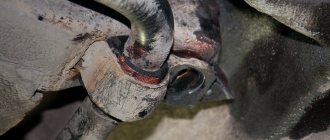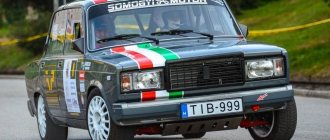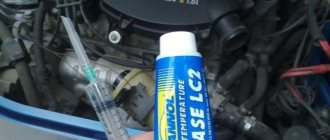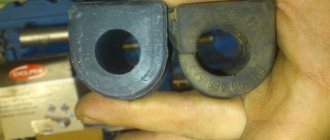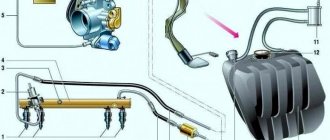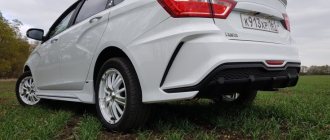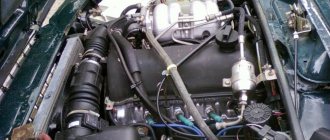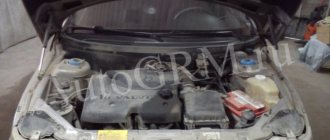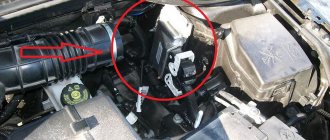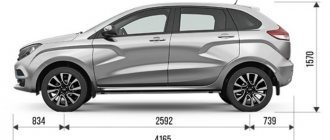The creaking of stabilizer bushings is a painful problem for all Vestavods. While some are waiting for a solution from the factory and driving the same way, others are trying by hook or by crook to solve this problem on their own with the help of teammates, etc.
Many foreign-made cars have similar problems (fluence, Rio), but their owners do not pay attention to this and drive in peace. But the Lada driver is a diagnosis, so let’s try to figure out the squeaking of the bushings.
What's the matter?
The reason for the dissatisfaction of many Newsmakers is the creaking. It is no secret that the stabilizer bushings of the domestic model very soon begin to creak, and sometimes this happens almost immediately after purchase. There have been cases when the car did not have time to travel even 1,500 km, and some manage to drive without making noise for less than 1,000 km. As for the frequency of squeaking, surveys show that this happens in approximately 60% of cars.
Creaking is typical for many Vestas
This creak can be clearly heard in the video.
It is also worth noting that such a squeak is rarely heard constantly. Usually it appears and then disappears. In this case, the problem is extremely clear - the quality of the material or the manufacturing of the components is not high enough.
In this case, there are two solutions:
- Contacting the dealer;
- Independent work.
In general, both options are working, however, both the first and second have certain disadvantages.
Replacing front stabilizer bushings
Regardless of the car model, the general procedure for replacing bushings remains the same. Only the instruments and some details of the procedure change. Even a novice driver can guess what exactly needs to be done as an additional action.
Front stabilizer bushing
To replace bushings, follow these steps:
- Place the car stationary on a pit or lift.
- Using tools, loosen the bolts of the front wheels.
- Remove the car wheels completely.
- Unscrew the nuts securing the struts to the stabilizer.
- Separate the struts and stabilizer.
- Loosen the rear bolts securing the bracket framing the bushing and unscrew the front ones.
- Using available tools, remove dirt from the area where the new bushings will be installed.
- Using silicone spray or soap solution, thoroughly lubricate the inside of the bushings.
- Install the bushings and perform a series of procedures inverse to those listed to return the car to working condition.
To install new bushings on some car models, it may be necessary to remove the crankcase protection. This will make the replacement process easier.
Replacement of the rear stabilizer bushings is carried out in the same way. The only thing is that removing the front bushings is sometimes more difficult due to the complexity of the car's front design. If the driver manages to change the front bushings, then he can probably cope with replacing the rear bushings.
Often the reason for replacing bushings is that they squeak. This factor, although not critical, still causes inconvenience to many drivers and passengers.
Contacting the dealer and AvtoVAZ’s position
If you have decided to contact a Lada dealership, you will most likely be unpleasantly surprised. The fact is that the Russian automaker, although it recognized the problem, took the simplest path to solving the issue.
At the dealership, the bushings are lubricated with grease.
The craftsmen do not replace the bushings, but simply lubricate them with PMS 400 grease. To carry out lubrication work, the unit is disassembled and then reassembled. PMS 400 is an emulsion-based lubricant with adhesive properties. It is widely used in defoamers and in plastic-to-metal contact areas. It has hydraulic, shock-absorbing, cooling and damping properties.
The result of using this lubricant is twofold. The Vesta stabilizer bushings actually stop squeaking, but this does not last long. The reason is that the lubricant is quickly washed out (literally within 100-150 km) and the sounds are heard again. This moment is especially pronounced in the fall, during rainy weather.
When is the transverse stabilizer bushing replaced?
The degree of wear of the bushing can be determined during a routine inspection. Cracks, changes in the properties of rubber, the appearance of abrasions - all this indicates that the part needs to be changed . Typically, bushings are replaced every 30,000 km . Experienced owners advise changing all bushings at once, regardless of their external condition.
During a routine inspection, the bushings may become dirty. They should be cleaned of dirt so as not to provoke accelerated wear of the part.
Unscheduled replacement of bushings is necessary when the following symptoms occur:
- steering wheel play when the car turns;
- noticeable vibration of the steering wheel;
- body roll, accompanied by characteristic unusual sounds (clicks, squeaks);
- vibration in the car suspension, accompanied by extraneous noise;
- when driving in a straight line, the car pulls to the side;
- general instability.
Detection of such problems requires urgent diagnosis. Primary attention should be paid to the bushings. By replacing them, you can check the operation of the car, and if signs of malfunction remain, an additional inspection should be carried out.
Independent work
In this case, there are several ways:
- Bushing lubrication;
- Replacement with analogues.
Bushing lubrication
If you choose this option, everything is done exactly the same as when contacting a dealership. However, car owners choose the lubricant themselves. Some people buy regular mastic, others use foreign lubricants, for example, Japanese ones.
Owners buy different lubricants
Be that as it may, these are only temporary measures, since mastic and other lubricants are still quickly washed out. It may last a little longer, but that doesn't solve the problem.
Replacement with analogues
According to reviews from owners, most often either bushings from Chevrolet Niva or components from KIA are used.
Bushings from Chevrolet Niva
Elements from this model are suitable for Lada Vesta, which can be bought at almost any car store. In addition, they can be ordered online using the following article numbers:
— 2123-2906046;
— 2123-2906040.
Stabilizer bushings from Chevrolet Niva
The second type of product has larger dimensions, so it is used more often. The price of bushings from Chevrolet Niva is about 150 rubles per pair. However, there are also polyurethane products on sale, which are often painted in bright colors (yellow, red, etc.). The price of polyurethane products reaches 250 rubles per piece.
You can purchase products from one of the resources below:
- https://www.autopiter.ru/goods/21232906046/rossiya/id51385878
- https://niva-lada4x4.ru/product_info.php?products_id=4152
- https://tankomobile.ru/polyurethan-chevy-niva.html
- https://www.nivashop.ru/catalog.html?idc=420&stype=4
However, Vest owners note that elements from the ChevyNiva also often creak, and it doesn’t make much difference what material they are made of - rubber or polyurethane.
Bushings from KIA
These are more expensive components, which can be purchased under article number KSBSOULF or 54813-2K100. The price for such products is significantly higher than for similar ones from ChevyNiva. Usually the cost varies between 400-650 rubles, but the price can reach 850 rubles per piece. Therefore, it is recommended to monitor offers from various suppliers before purchasing. In this case, you need to buy only original products. Purchasing a non-original one is fraught with the same creaking noise, which is extremely unpleasant, because bushings from a Korean manufacturer are not cheap.
Products from Kia
You can purchase them on one of the following sites:
- https://koreanaparts.ru/product/548132K100/730
- https://www.autodoc.ru/part/hyundai-kia—647/548132k100/
- https://www.autopiter.ru/goods/548132k100/hyundai-kia/id11105217
- https://plentycar.ru/autopart/1981834
In addition, it is worth taking into account the configuration of parts from HYUNDAI-KIA, which differs significantly from that of the Lada Vesta. For this reason, along with the bushings, you need to buy brackets for them, which are sold under article number 54814-1G000. The price tag for them ranges from 300 to 500 rubles per piece.
Comparison of Russian and Korean elements
You can order brackets online at the following addresses:
- https://koreanaparts.ru/product/548141G000/730
- https://nomer52.ru/kronshtejn-vtulki-stabilizatora_hyundai_elantra-hd_548141g000_mobis_i126/
- https://www.autodoc.ru/part/hyundai-kia—647/548141g000/
- https://www.autopiter.ru/goods/548141g000/hyundai-kia/id11105233
Bracket for bushings from Kia
Stabilizer bushings creaking
Often, owners of passenger cars complain about creaking stabilizer bushings. It often occurs during frost or dry weather. However, the conditions of occurrence manifest themselves individually.
Causes of squeaks
The main reasons for this problem are:
- low quality of the material from which the stabilizer bushings are made;
- rubber hardening in the cold, causing it to become inelastic and squeak;
- significant wear of the bushing or its failure;
- design features of the car (for example, Lada Vesta).
Methods for solving the problem
Some car owners try to lubricate the bushings with various lubricants (including silicone grease). However, as practice shows, this gives only a temporary effect (and in some cases it does not help at all). Any lubricant attracts dirt and debris, thus forming an abrasive. And this leads to a decrease in the life of the bushing and the stabilizer itself. Therefore, we do not recommend that you use any lubricants .
In addition, it is not recommended to lubricate the bushings due to the fact that this violates the principle of their operation. After all, they are designed to tightly hold the stabilizer. Being essentially a torsion bar, it works in torsion, creating resistance to the car's roll when cornering. Therefore, it must be securely fastened in the sleeve. And if there is lubrication, this becomes impossible, since it can still turn, making a creaking noise again.
The recommendation of most automakers regarding this defect is to replace the bushings . So, general advice for car owners who are faced with the problem of squeaking from the stabilizer is to drive with the squeaking for a certain time (one or two weeks is enough). If the bushings do not “grind in” (especially for new bushings), they will need to be replaced.
In some cases, replacing rubber bushings with polyurethane ones . However, this depends on the machine and the bushing manufacturer. Therefore, responsibility for the decision to install polyurethane bushings lies solely with car owners.
Stabilizer bushings must be replaced every 20-30 thousand kilometers. Look for the specific value in the manual for your car.
To solve the problem, some car owners wrap the part of the stabilizer that is inserted into the bushing with electrical tape, thin rubber (for example, a piece of a bicycle tube) or cloth. Original bushings (for example, Mitsubishi) have a fabric insert inside. This solution will allow the stabilizer to be seated more tightly in the bushing and will relieve the car owner from unpleasant sounds.
